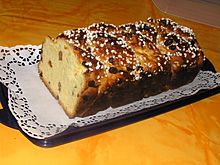Cozonac facts for kids

Bulgarian Kozunak with raisins, braided and sprinkled with sugar.
|
|
| Alternative names | Bulgarian: козунак |
|---|---|
| Type | Yeast cake |
| Course | Dessert |
| Region or state | Bulgaria, North Macedonia, Serbia, Romania, Moldova |
| Main ingredients | Wheat flour, butter, milk,eggs,sugar,yeast, dried fruit, nuts, citrus peel, flavorings like vanilla or rum |
Cozonac (pronounced ko-zo-NAK) is a special sweet bread. It's a popular treat in many countries in Southeastern Europe. You'll find it in places like Romania, Bulgaria, Serbia, and North Macedonia.
This delicious bread is rich with eggs, milk, and butter. People often make it for special holidays. In Romania, Serbia, and Bulgaria, it's a traditional food for Easter. In Romania and Moldova, it's also enjoyed on Good Friday. The name Cozonac comes from a Bulgarian word meaning "hair." This is because some versions look like braided hair!
Cozonac was even chosen to represent Romania in a special event called Café Europe. This happened in 2006 during the Austrian presidency of the European Union.
Contents
Where Did Cozonac Come From?
Sweet breads like Cozonac have a very long history. The first recipe for a bread similar to Cozonac appeared in a cookbook in Great Britain in 1718. That old recipe suggested baking it in long, narrow pans, which is still a good idea today!
Today, Cozonac is a favorite traditional food. It's especially popular in North Macedonia, Romania, Moldova, and Bulgaria.
Making Cozonac: Ingredients and Steps
Cozonac is a sweet bread made with simple ingredients. These include milk, yeast, eggs, sugar, and butter. All these ingredients are mixed together to form a dough. Then, the dough is allowed to rise, which makes it light and fluffy. Finally, it's baked until golden brown.
In Bulgaria, people often add lemon zest to the dough. This gives the bread a lovely citrusy smell and taste. The Romanian version also uses lemon zest.
In North Macedonia, people traditionally bake a sweet bread called kozunak for Easter. It often has raisins and sultanas. It's sometimes shaped like a girl's braided hair, which is why its name comes from the Bulgarian word for hair.
Romanian Cozonac recipes can be a bit different depending on the region. The basic dough is usually the same. It's a sweet bread made from flour, eggs, milk, butter, sugar, and salt.
People often add extra yummy things to Cozonac. These can include:
Sometimes, Cozonac is sprinkled with poppy seeds on top. Other times, it has a delicious filling inside. A common filling is a mix of ground walnuts with ground poppy seeds, cocoa powder, rum essence, or raisins.
To make a filled Cozonac, the dough is rolled flat. The filling is spread evenly over it. Then, the dough is rolled up, often looking a bit like a pinwheel. When it bakes, the filling creates a beautiful swirl inside the bread.
Other Sweet Breads Around the World
Cozonac is a rich, sweet bread that uses eggs. Many cultures have similar types of sweet breads. These breads are often enjoyed during holidays or special occasions.
Here are some examples of similar sweet breads from other countries:
- Badnji kruh in Croatian cuisine
- Folar de páscoa in Portuguese cuisine
- Brioche in French cuisine
- Kulich in Russian cuisine
- Panettone in Italian cuisine
- Hot cross bun in English cuisine
- Challah in Jewish cuisine
- Stollen in German cuisine
Sweet, brioche-like breads are also traditional in countries like Hungary and the Czech Republic.
See also
 In Spanish: Cozonac para niños
In Spanish: Cozonac para niños


